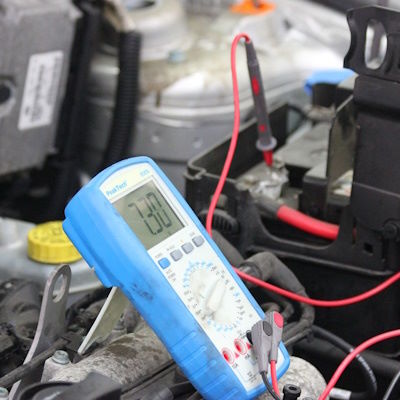
Electric systems cause no end of confusion. Knowing how to check over your system can be a lifesaver!
You will need a volt meter, which doesn’t have to be impressive, just in the 10 to 20 Volt DC range.
Vans can have three forms of charging. We need to make sure none of them are giving us any charge before we can start. So, before you plug into your mains hookup or start your engine, cover the solar panel with a blanket. Give it all a few minutes to settle down. This will mean there are no charging inputs currently active.
- Check the voltage at your starter battery with your Voltmeter and record it as “Default Starter”
- Check the voltage at your leisure battery with your Voltmeter and record it as “Default Leisure”
(If you have more than 1 battery connected together, test diagonally across the pair – You should see where the negative and positive connections are made, use those, the other ones are just for joining the batteries together).
This gives us a baseline voltage for each of your battery systems, the Vehicle or Starter and your leisure system.
Solar
Is it Sunny? Uncover the panel, and ensure the panel is in the sun with no shadows across it. If there is no sun then it might not be the best time to test your solar system performance.
- Check the voltage at your starter battery with your Voltmeter and record it as “Starter – Solar Only”
- Check the voltage at your leisure battery with your Voltmeter and record it as “Leisure – Solar Only”
You should hopefully see the volts go up on your leisure and nothing changed on your starter.
You could trace the wires to your solar regulator, and also test the voltage on your solar panel direct input and make a note of that as “Direct Solar Panel Volts”. If this is lower than your battery volts, you have an issue. It depends on your panel specification, but they are usually 18v and over.
Recover the panel for the next tests.
Engine System
Start the engine.
- Check the voltage at your starter battery with your Voltmeter and record it as “Starter – Engine Running”
- Check the voltage at your leisure battery with your Voltmeter and record it as “Leisure – Engine Running”
You should see that the voltage at the starter increases. Your engine is running and the alternator is giving out a charge – this is good!
You should see that the voltage at the leisure battery goes up. There may be a delay whilst things settle down, but a rise in the starter voltage should signal to your charging system that it’s time to open up and charge the leisure battery. If your leisure battery voltage stays the same, you have an issue with your engineer running charge system.
Turn off the engine for the last test.
Mains System
Plug into mains.
Find your consumer unit, and ensure everything is on.
Follow the cables out of your consumer unit to find your charger, is it on?
- Check the voltage at your starter battery with your Voltmeter and record it as “Starter – Engine Running”
- Check the voltage at your leisure battery with your Voltmeter and record it as “Leisure – Engine Running”
If your charger has kicked in the voltage should have gone up.
Summary
Using this you can see what is charging and what is not. If any volts are below 12 then you have issues that need resolving fast.
If any of the charging tests do not take the batteries above 13 then you have issues.
If there are no changes, then it’s probably blow fuses, or disconnected items.
Before a trip it’s always best to ensure your systems are working correctly, never assume they are – it’s a vehicle you can never assume everything will always be OK when it comes to a vehicle!

